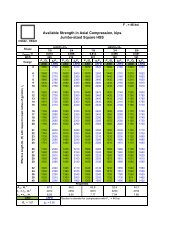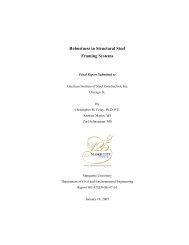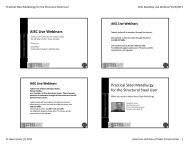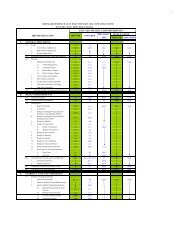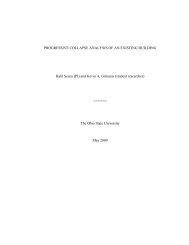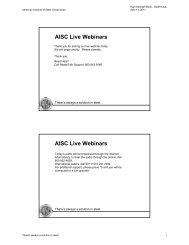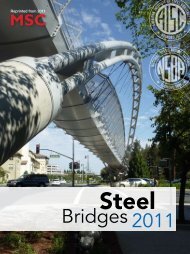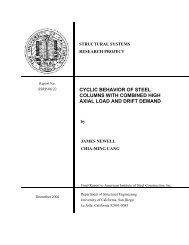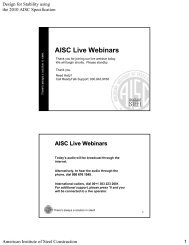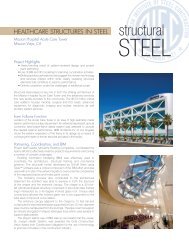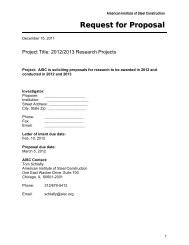Steel Pricing NASCC - AISC
Steel Pricing NASCC - AISC
Steel Pricing NASCC - AISC
Create successful ePaper yourself
Turn your PDF publications into a flip-book with our unique Google optimized e-Paper software.
At <strong>AISC</strong> we are working hard to send a positive message into a confused design and constructioncommunity. What is that message? It is a response to the primary concerns of owners, generalcontractors and construction managers who are asking:• What is the impact of increased structural steel prices on my project?• What is the impact of the current volatility on the availability of structural steel for myproject?• How can you help me navigate any surprises that await me as I move forward on myproject?So how do we (and I mean both those of us at <strong>AISC</strong> and each of you) answer those questions?The first question to answer is “What is the impact of increased structural steel prices on myproject”The cost of the project will increase. But, it should be recognized that increases in the mill priceof steel have only a small impact on the overall cost of the project. On a typical project, the costof the fabricated and erected steel frame represents 10% to 12% of the overall project cost. Ofthat steel frame package, mill material accounts for only 20% to 25% of the cost. This meansthat mill material accounts for only 2% to 3% of the project cost. A 40% increase in mill costwould equate to an increase of one percent in project cost.At the same time it is necessary to recognize that many facets of a construction project are alsoundergoing significant cost increases. Concrete prices are up as a result of increases in rebarpricing, serious availability problems relating to post-tensioning strand and plywood formingcosts, HVAC costs have increased as the cost of sheet metal has increased, the electrical tradesare concerned about conduit pricing and the plumbers see their pipe costs rapidly escalating.Project cost increases cannot be laid solely at the feet of the structural steel industry and theymost certainly cannot be brought under control by simply shifting to a different framing system.It is not just the cost of the framing system on a project that should be compared – to fullyappreciate the impact of the selection of steel frame the savings in foundation costs due to alighter structure and general condition savings, equipment rental reductions and constructionloan savings due to accelerated schedules should be taken into account.Our regional engineers, who are our front line in this battle, are consistently experiencing projectowners, general contractors and architects who are stepping back to review their costing numberson projects already designed in steel to see if a concrete solution would be more cost effective.What they are discovering is that structural steel remains the market leader for optimizing andreducing the cost of a project. In many cases, the cost increases for competing materials areresulting in a greater impact on project cost than the increases for structural steel.Historically, if you examine Bureau of Labor statistics since 1980 you will find that the cost ofready mix concrete has increased by 52% while the average cost of structural steel has onlyincreased by 21%.Does this mean that our message to every owner, contractor and architect should be that concretepricing is up more than steel pricing and that they should just pay the new prices and be quiet?3



